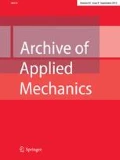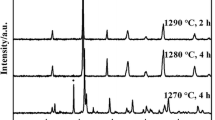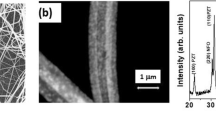Abstract
In this contribution, we analyze the properties of two-phase magneto-electric (ME) composites. Such ME composite materials have raised scientific attention in the last decades due to many possible applications in a wide range of technical devices. Since the effective magneto-electric properties significantly depend on the microscopic morphology, we investigate in more detail the changes in the in-plane polarization due to an applied magnetic field. It was shown in previous works that it is possible to grow vertically aligned nanopillars of magnetostrictive cobalt ferrite in a piezoelectric barium titanate matrix by pulsed laser deposition. Based on x-ray linear dichroism, the displacements of titanate ions in the matrix material can be measured due to an applied magnetic field near the boundary of the interface between the matrix and the nanopillars. Here, we focus on (1–3) fiber-induced composites, based on previous experiments, where cobalt ferrite nanopillars are embedded in a barium titanate matrix. In the numerical simulations, we adjusted the boundary value problem to match the experimental setup and compare the results with previously made assumptions of the in-plane polarizations. A further focus is taken on the deformation behavior of the nanopillar over its whole height. Such considerations validate the assumption of the distortion of the nanopillars under an external magnetic field. Furthermore, we analyze the resulting magneto-electric coupling coefficient.








Similar content being viewed by others
References
Astrov, D.N.: Magnetoelectric effect in chromium oxide. J. Exp. Theor. Phys. 40, 1035–1041 (1961)
Berlincourt, D., Jaffe, H.: Elastic and piezoelectric coefficients of single-crystal barium titanate. Phys. Rev. 111, 143–148 (1958). https://doi.org/10.1103/PhysRev.111.143
Bibes, M., Barthélémy, A.: Multiferroics: towards a magnetoelectric memory. Nat. Mater. 7(6), 425–426 (2008). ISSN 1476-1122
Bichurin, M.I., Petrov, V.M., Srinivasan, G.: Theory of low-frequency magnetoelectric coupling in magnetostrictive-piezoelectric bilayers. Phys. Rev. B 68, 054402 (2003)
Bichurin, M.I., Petrov, V.M., Averkin, S.V., Liverts, E.: Present status of theoretical modeling the magnetoelectric effect in magnetostrictive-piezoelectric nanostructures. Part I: low frequency and electromechanical resonance ranges. J. Appl. Phys. 107(5), 053904 (2010)
Brown, W.F., Hornreich, R.M., Shtrikman, S.: Upper bound on the magnetoelectric susceptibility. Phys. Rev. 168(2), 574–577 (1968)
Cheong, S.-W., Mostovoy, M.: Multiferroics: a magnetic twist for ferroelectricity. Nat. Mater. 6(1), 13–20 (2007). ISSN 1476-1122
Crottaz, O., Rivera, J.-P., Revaz, B., Schmid, H.: Magnetoelectric effect of \(\text{ Mn }_3\text{ B }_7\text{ O }_{13}\text{ I }\) boracite. Ferroelectrics 204, 125–133 (1997)
Dent, A.C., Bowen, C.R., Stevens, R., Cain, M.G., Stewart, M.: Effective elastic properties for unpoled barium titanate. J. Eur. Ceram. Soc. 27, 3739–3743 (2007)
Eerenstein, W., Wiora, M., Prieto, J.L., Scott, J.F., Mathur, N.D.: Giant sharp and persistent converse magnetoelectric effects in multiferroic epitaxial heterostructures. Nat. Mater. 6(5), 348–351 (2007)
Harshé, G., Dougherty, J.P., Newnham, R.E.: Theoretical modeling of multilayer magnetoelectric composites. Int. J. Appl. Electromagn. Mater. 4, 145–159 (1993)
Harshé, G., Dougherty, J.P., Newnham, R.E.: Theoretical modeling of 3–0/0–3 magnetoelectric composites. Int. J. Appl. Electromagn. Mater. 4, 161–171 (1993)
Hill, N.A.: Why are there so few magnetic ferroelectrics? J. Phys. Chem. B 104, 6694–6709 (2000)
Huang, J.H., Kuo, W.-S.: The analysis of piezoelectric/piezomagnetic composite materials containing ellipsoidal inclusions. J. Appl. Phys. 81, 1378–1386 (1997)
Jayachandran, K.P., Guedes, J.M., Rodrigues, H.C.: A generic homogenization model for magnetoelectric multiferroics. J. Intell. Mater. Syst. Struct. 25, 1243–1255 (2014)
Jin, K., Aboudi, J.: Macroscopic behavior prediction of multiferroic composites. Int. J. Eng. Sci. 94, 226–241 (2015)
Khomskii, D.: Classifying multiferroics: mechanisms and effects. Physics 2, 20 (2009)
Labusch, M., Etier, M., Lupascu, D.C., Schröder, J., Keip, M.-A.: Product properties of a two-phase magneto-electric composite: synthesis and numerical modeling. Comput. Mech. 54, 71–83 (2014)
Lee, J.S., Boyd, J.G., Lagoudas, D.C.: Effective properties of three-phase electro-magneto-elastic composites. Int. J. Eng. Sci. 43(10), 790–825 (2005)
Li, Z., Chan, S.-K., Grimsditch, M.H., Zouboulis, E.S.: The elastic and electromechanical properties of tetragonal \(\text{ BaTiO }_3\) single crystals. J. Appl. Phys. 70, 7327–7332 (1991)
Li, Z., Fisher, S., Liu, J.Z., Nevitt, M.V.: Single-crystal elastic constants of Co-Al and CoFe spinels. J. Mater. Sci. 26, 2621–2624 (1991)
Liu, G., Nan, C.W., Xu, Z., Chen, H.: Coupling interaction in multiferroic \(\text{ BaTiO }_3\)–\(\text{ CoFe }_2\text{ o }_4\) nanostructures. J. Phys. D Appl. Phys. 38, 2321–2326 (2005)
Martin, L.W., Chu, Y.-H., Ramesh, R.: Advances in the growth and characterization of magnetic, ferroelectric, and multiferroic oxide thin films. Mater. Sci. Eng. R Rep. 68(46), 89–133 (2010). ISSN 0927-796X
Miehe, C., Rosato, D., Kiefer, B.: Variational principles in dissipative electro-magneto-mechanics: a framework for the macro-modeling of functional materials. Int. J. Numer. Methods Eng. 86, 1225–1276 (2011)
Nan, C.-W., Liu, G., Lin, Y., Chen, H.: Magnetic-field-induced electric polarization in multiferroic nanostructures. Phys. Rev. Lett. 94(19), 197203 (2005)
Ramesh, R., Spaldin, N.A.: Multiferroics: progress and prospects in thin films. Nat. Mater. 6(1), 21–29 (2007). ISSN 1476-1122
Rivera, J.-P.: On definitions, units, measurements, tensor forms of the linear magnetoelectric effect and on a new dynamic method applied to Cr–Cl boracite. Ferroelectrics 161, 165–180 (1994)
Rivera, J.-P., Schmid, H.: On the birefringence of magnetoelectric \(\text{ BiFeO }_3\). Ferroelectrics 204, 23–33 (1997)
Schmid, H.: Multi-ferroic magnetoelectrics. Ferroelectrics 162, 317–338 (1994)
Schmitz-Antoniak, C., Schmitz, D., Borisov, P., de Groot, F., Stienen, S., Warland, A., Krumme, B., Feyerherm, R., Dudzik, E., Kleemann, W., Wende, H.: Electric in-plane polarization in multiferroic \(\text{ CoFe }_2\text{ O }_4/\text{ BaTiO }_3\) nanocomposite tuned by magnetic fields. Nat. Commun. 4, 1–8 (2013)
Schmitz-Antoniak, C., Schmitz, D., Borisov, P., de Groot, F., Stienen, S., Warland, A., Krumme, B., Feyerherm, R., Dudzik, E., Kleemann, W., Wende, H.: Electric in-plane polarization in multiferroic \(\text{ CoFe }_2\text{ O }_4/\text{ BaTiO }_3\) nanocomposite tuned by magnetic fields: supplementary information. Nat. Commun. 4, (2013)
Schröder, J., Gross, D.: Invariant formulation of the electromechanical enthalpy function of transversely isotropic piezoelectric materials. Arch. Appl. Mech. 73, 533–552 (2004)
Schröder, J., Labusch, M., Keip, M .A.: Algorithmic two-scale transition for magneto-electro-mechanically coupled problems \(\text{ FE }^2\)-scheme: localization and homogenization. Cmiamae 302, 253–280 (2016)
Shi, Y., Gao, Y.: A nonlinear magnetoelectric model for magnetoelectric layered composite with coupling stress. J. Magn. Magn. Mater. 360, 131–136 (2014)
Spaldin, N.A., Fiebig, M.: The renaissance of magnetoelectric multiferroics. Science 309, 391–392 (2005)
Srinivas, S., Li, J.Y., Zhou, Y.C., Soh, A.K.: The effective magnetoelectroelastic moduli of matrix-based multiferroic composites. J. Appl. Phys. 99(4), 043905 (2006)
van Suchtelen, J.: Product properties: a new application of composite materials. Philips Res. Rep. 27, 28–37 (1972)
Vaz, C.A.F., Hoffman, J., Ahn, C.H., Ramesh, R.: Magnetoelectric coupling effects in multiferroic complex oxide composite structures. Adv. Mater. 22, 2900–2918 (2010)
Wang, Y., Hu, J., Lin, Y., Nan, C.-W.: Multiferroic magnetoelectric composite nanostructures. Nat. Asia Pac. Asia Mater. 2, 61–68 (2010)
Zheng, H., Wang, J., Lofland, S.E., Ma, Z., Mohaddes-Ardabili, L., Zhao, T., Salamanca-Riba, L., Shinde, S.R., Ogale, S.B., Bai, F., Viehland, D., Jia, Y., Schlom, D.G., Wuttig, M., Roytburd, A., Ramesh, R.: Multiferroic \(\text{ BaTiO }_3\)–\(\text{ CoFe }_2\text{ o }_4\) nanostructures. Science 303(5658), 661–663 (2004). https://doi.org/10.1126/science.1094207. ISSN 0036-8075
Zheng, Y.X., Cao, Q.Q., Zhang, C.L., Xuan, H.C., Wang, L.Y., Wang, D.H., Du, Y.W.: Study of uniaxial magnetism and enhanced magnetostriction in magnetic-annealed polycrystalline \(\text{ CoFe }_2\text{ o }_4\). J. Appl. Phys. 110(4), 043908 (2011). https://doi.org/10.1063/1.3624661
Zohdi, T.I.: Simulation of coupled microscale multiphysical-fields in particulate-doped dielectrics with staggered adaptive fdtd. Comput. Methods Appl. Mech. Eng. 199, 3250–3269 (2010)
Zohdi, T.I.: Electromagnetic Properties of Multiphase Dielectrics. Springer, Berlin (2012)
Acknowledgements
We gratefully acknowledge the financial support by the “Deutsche Forschungsgemeinschaft” (DFG), research group “Ferroische Funktionsmaterialien - Mehrskalige Modellierung und experimentelle Charakterisierung”, Project 1 (SCHR 570/12-2) and Project 2 (WE 2623/13-2).
Author information
Authors and Affiliations
Corresponding author
Additional information
Publisher's Note
Springer Nature remains neutral with regard to jurisdictional claims in published maps and institutional affiliations.
Appendix
Appendix
The equations for the stress field \({\varvec{\sigma }}\), dielectric displacement \({{\varvec{D}}}\) and magnetic induction \({{\varvec{B}}}\) for piezoelectricity and piezomagnetism in direct and index notation
and
They can be reformulated to
With (17), Eqs. (15) and (16) can be reformulated to
and
In our approach, we use a coordinate-invariant setting based on the following invariants for the transversal isotropic material law
with the second-order structural tensor \({{\varvec{m}}}:= {{\varvec{a}}}\otimes {{\varvec{a}}}\), then the quadratic electric enthalpy function \(\psi ^{*}\) is given with
Then, \({\varvec{\sigma }}= \partial _{{\varvec{\varepsilon }}}\psi ^{*}\), \({{\varvec{D}}}= -\partial _{{{\varvec{E}}}}\psi ^{*}\) and \({{\varvec{B}}}= -\partial _{{{\varvec{H}}}}\psi ^{*}\) appear as
and
With the second derivatives of Eqs. (22), (23) and (24), \(\mathbb {C} = \partial _{{\varvec{\varepsilon }}}{\varvec{\sigma }}\), \({{\varvec{e}}}= \partial _{{\varvec{\varepsilon }}}{{\varvec{D}}}\), \({{\varvec{q}}}= \partial _{{\varvec{\varepsilon }}}{{\varvec{B}}}\), \({\varvec{\epsilon }}= \partial _{{{\varvec{E}}}}{{\varvec{D}}}\) and \({\varvec{\mu }}= \partial _{{{\varvec{H}}}}{{\varvec{B}}}\), we get
with the fourth-order unit tensor \(\mathbb {I}\), \(\Xi = {{\varvec{a}}}\otimes \mathbf 1 \otimes {{\varvec{a}}}+ {{\varvec{a}}}\otimes \mathbf 1 \otimes {{\varvec{a}}}\) and \({\varvec{\theta }}= \dfrac{1}{2}({{\varvec{a}}}\otimes \mathbf 1 + {{\varvec{a}}}\otimes \mathbf 1 )\). Taking these equations written in Voigt notation and renaming the parameters which are equal, we get with the preferred direction \({{\varvec{a}}}= {{\varvec{x}}}_3\) of the transversal isotropic material
and
We can identify
Rights and permissions
About this article
Cite this article
Labusch, M., Lemke, V., Schmitz-Antoniak, C. et al. FEM analysis of a multiferroic nanocomposite: comparison of experimental data and numerical simulation. Arch Appl Mech 89, 1157–1170 (2019). https://doi.org/10.1007/s00419-019-01534-z
Received:
Accepted:
Published:
Issue Date:
DOI: https://doi.org/10.1007/s00419-019-01534-z




